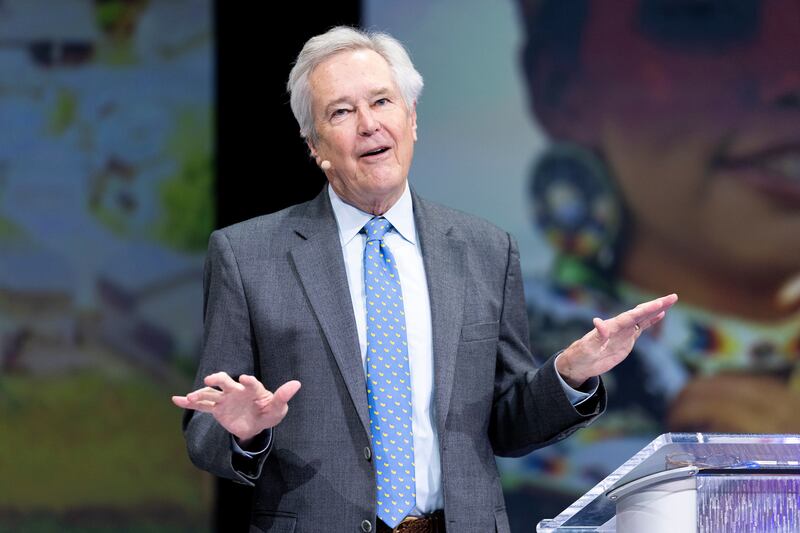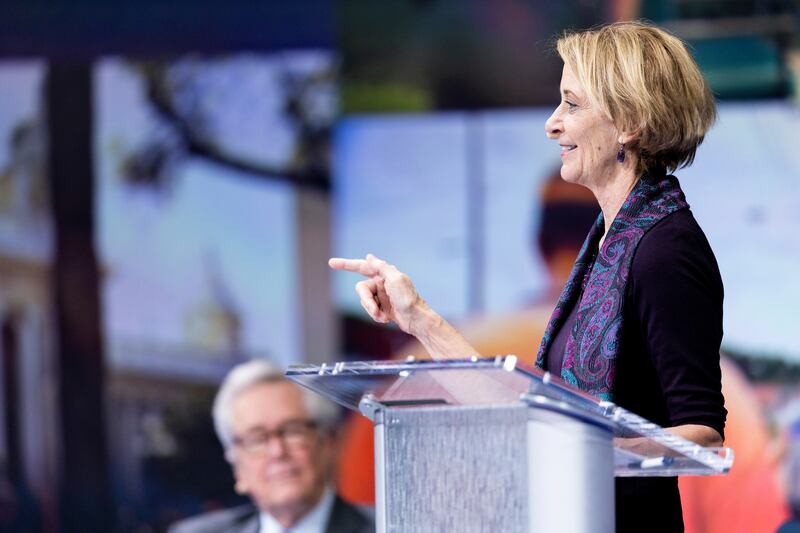Creative local solutions are flourishing across the United States, right under the noses of many national journalists and most news consumers, a bestselling journalism couple said Tuesday at Brigham Young University.
Over the past decade, as American divisions appeared to deepen, James and Deborah Fallows immersed themselves in the nation’s towns and emerged with a unique vision of hope rooted in replicable portraits of resilience.
“A time of national strain seems to be leading to a time of great and under-publicized experimentation and renewal at the local level,” Jim Fallows said.
The power couple discovered this perspective as they crisscrossed the nation for four years in a single-engine prop airplane and then published the 2018 bestselling book “Our Towns: A 100,000-Mile Journey Into the Heart of America” and produced the 2021 HBO documentary “Our Towns.”
On Tuesday, they brought the lessons they learned to BYU’s Marriott Center as the fifth lecture in the university’s six-part forum series this year on “Creating the Beloved Community.” Martin Luther King Jr. popularized the idea of building loving communities where people strive to benefit the common good.
“The last decade, when so much of the national news has been of strife and of setback and of challenge and of reasons to lose hope, has been a time of unusual, flourishing experimentation at the local level,” Jim Fallows said. “You find experimentation in civic engagement. You find experimentation in kinds of schooling. You find experimentation in sustainability. You find experimentation in the looks of downtowns.”
Calling each other Jim and Deb while alternating time at the podium, the couple contended that Americans today and historically focus on national challenges and weaknesses and overlook not only the strengths of their own local communities but also the opportunities they have to make a difference in them.
The couple lived in China for several years, where they found the opposite to be true.
“One of my views of China is that China often looks most imposing when you see it from a distance and can look most fragile when you see it up close,” Jim Fallows said. “I’m going to contend that the reverse is true in the United States right now — that our problems are most evident from a distance (or seen on a national scale), and the sources of encouragement are most visible when you look up close” at local communities.

He said the story of America in nearly every decade has been of well-known crises that affect the nation broadly and generate lesser-known creative responses in its cities and towns.
“We know about the crises, and we often don’t fully know about the creative response, because so much of it is small town, so much of it is community, so much of it is local,” he said.
Local libraries are key sources of creative solutions
Deb Fallows shared several stories of creative solutions the couple found around the nation. The lessons they learned, she said, were that the creative responses were most effective when centered in local public institutions like libraries.
For example, the library in Bend, Oregon, designated community librarians who joined local clubs and organizations and worked with them on solutions. The library as a result began to offer tax assistance and held book-a-lawyer and book-a-nurse events to help connect people in need with resources.
She said libraries build trust because they offer services without judgment and also serve as second responders, helping their communities return to normalcy after trauma like a flood or other disaster. They played this role during the COVID-19 pandemic for many schoolchildren who did not have access to Wi-Fi or equipment they needed to do schoolwork online.

She said local public arts are also vital to renewing communities and emphasized the need for communities to consider how to help their young people not only thrive but want to stay or return and continue to help build their towns.
Libraries knit people together while local arts knit time together because they explore history, the present and the future, she said.
A problem with national journalism
National journalists overshadow local strengths when they go to small American towns and only ask questions about national politics or issues, said Jim Fallows, who is known for his decades of reporting for “The Atlantic” and is winner of both the American Book Award and National Magazine Award.
During a question-and-answer session after the forum, he said it’s polarizing when national journalists who ask regular people how they feel about Donald Trump or Barack Obama. It also makes small-town Americans seem one-dimensional instead of revealing the depth of their communities’ strengths.
The couple’s town-hopping travels revealed what they said is broad hope for America’s future. Their message was that towns thrived best when people were optimistic in a specific way. Complacent optimism, or the hope things could eventually get better somehow, is not as powerful as conditional optimism, or the belief that things could get better if everybody tries.
“What Deb and I have found around the country is that the closer up you see the United States, the more that you look at the neighborhood and community level, the more hopeful you feel that the story of the United States over its centuries has been a kind of tension between national-level development — sometimes for good, sometimes for bad — and local-level responses. And at a time when national-level problems have been so well known, we feel as if the local level is the place where you find things most encouraging,” Jim Fallows said.
Five ways people can make a difference in their local community
They shared five ways that BYU students can make a difference in the communities where they choose to settle and build lives. He said they should learn to recognize the moment and recognize the points of leverage.
- Engage in anything. Jim Fallows suggested that it can start as simply as deciding to pick up any trash one passes on the ground.
- Run for any elected office at some point, or support a colleague’s run. Asking others for their political support is humbling, exposes one to a range of opinions and is a schoolroom for how people compromise or don’t. Moderate voices are needed.
- Support local journalism. “The sea in which local democracy swims is information provided by local newspapers,” Jim Fallows said. Subscribe and pay attention to local news.
- When in doubt, plant a tree. A new tree is tangible and a proxy for both how people think about the local community and the larger way they think about the world.
- Think about what would make somebody who is different from you want to move there and build on it. “The American experiment is people of diverse backgrounds finding common ground,” Jim Fallows said.
Deb and Jim Fallows recently founded the Our Towns Civic Foundation to encourage American community renewal.
Jim Fallows, who was President Jimmy Carter’s chief speechwriter for two years, hosts a Substack site called Breaking the News. Deb Fallows is a linguist and writer published in The Atlantic, National Geographic, The Washington Monthly and others. She has worked at the Pew Research Center, Oxygen Media and Georgetown University.
The couple have two sons and four grandchildren.
Tuesday’s forum can be seen on-demand at BYUtv.org.
BYU’s series on ‘Creating the Beloved Community’
The Deseret News covered the previous four lectures in BYU’s series on “Creating the Beloved Community.”
- Martin Luther King III’s kickoff lecture in September ended with a rousing standing ovation from students moved by his call for them to “Rise up and take a stand against poverty, racism, war and violence.”
2. The Rev. Dr. Andrew Teal of Oxford’s Pembroke College spoke about building the beloved community as an Anglican priest who walks alongside his friends in The Church of Jesus Christ of Latter-day Saints.
3. BYU students stood and cheered in November when the Rev. Dr. William Barber II called on them to join a moral march on Washington next summer to revive and renew American democracy’s care for the vulnerable.
4. In January, journalist and popular “Hidden Brain” podcaster Shankar Vedantam drew parallels from the nonviolent tactics of Mahatma Gandhi and the Rev. Dr. Martin Luther King Jr. to Jesus Christ’s Sermon on the Mount.
The sixth and final lecture in the series will be held on March 29, when author Amy Chua is scheduled to speak at the Marriott Center. Chua, a Yale law professor, is author of “Battle Hymn of the Tiger Mother.”


